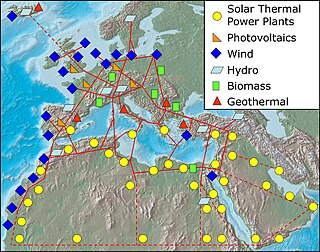
Renewable energy plays an important and growing role in the energy system of the European Union. The Europe 2020 strategy included a target of reaching 20% of gross final energy consumption from renewable sources by 2020, and at least 32% by 2030. The EU27 reached 22% in 2020, up from 9.6% in 2004. These figures are based on energy use in all its forms across all three main sectors, the heating and cooling sector, the electricity sector, and the transport sector.

As of December 2017, the European Union had a total installed wind capacity of 169.3gigawatts (GW). In 2017, a total of 15,680 MW of wind power was installed, representing 55% of all new power capacity, and the wind power generated 336 TWh of electricity, enough to supply 11.6% of the EU's electricity consumption.
Eddie O'Connor is an Irish businessman who is co-founder and chairman of Mainstream Renewable Power, a renewable energy group.
As of 2021 The island of Ireland has 5,585 megawatt and the Republic of Ireland has 4,309 MW of installed wind power nameplate capacity, the third highest per capita in the world. In 2020 wind turbines generated 36.3% of Ireland's electrical demand, one of the highest wind power penetrations in the world.
DESERTEC is a foundation that promotes the production of renewable energy in deserts. The project aims at creating a global renewable energy plan based on the concept of harnessing sustainable powers from sites where renewable sources of energy are more abundant and transferring it through high-voltage direct current transmission to consumption centers. The foundation also works on concepts involving green hydrogen. Multiple types of renewable energy sources are envisioned, but the natural climate of the deserts is key to creating the plan.
TenneT is a transmission system operator in the Netherlands and in a large part of Germany.

A floating wind turbine is an offshore wind turbine mounted on a floating structure that allows the turbine to generate electricity in water depths where fixed-foundation turbines are not feasible. Floating wind farms have the potential to significantly increase the sea area available for offshore wind farms, especially in countries with limited shallow waters, such as Japan, France and US West coast. Locating wind farms further offshore can also reduce visual pollution, provide better accommodation for fishing and shipping lanes, and reach stronger and more consistent winds.

The Burbo Bank Offshore Wind Farm is a 348 MW offshore wind farm located on the Burbo Flats in Liverpool Bay on the west coast of the UK in the Irish Sea. It consists of an original 90 MW wind farm commissioned in 2007 and a 258 MW extension completed in 2017.

The SuperSmart Grid (SSG) is a hypothetical wide area electricity network connecting Europe with northern Africa, the Middle East, and the IPS/UPS system of CIS countries. The system would unify super grid and smart grid capabilities into a comprehensive network. There are no planned locations for infrastructure or schedule explicitly for the SSG; the name is used to discuss the economic and technological feasibility of such a network and ways that it might gain political support.

A super grid or supergrid is a wide-area transmission network, generally trans-continental or multinational, that is intended to make possible the trade of high volumes of electricity across great distances. It is sometimes also referred to as a "mega grid". Super grids typically are proposed to use high-voltage direct current (HVDC) to transmit electricity long distances. The latest generation of HVDC power lines can transmit energy with losses of only 1.6% per 1,000 km.
The electricity sectors of the Republic of Ireland and Northern Ireland are integrated and supply 2.5 million customers from a combination of coal, peat, natural gas, wind and hydropower. In 2018 natural gas produced 51.8%, while wind turbines generated 28.1%, coal 7%, and peat 6.8% of Ireland's average electricity demand. In 2020 wind turbines generated 36.3% of Ireland's electrical demand, one of the highest wind power proportions in the world. While the United Kingdom was one of the first countries in the world to deploy commercial nuclear power plants, the island of Ireland has never had a nuclear power plant built on either side of the Irish border. Nuclear power in Ireland was discussed in the 1960s and 1970s but ultimately never phased in, with legislation now in place explicitly forbidding its introduction.

The European super grid is a possible future super grid that would ultimately interconnect the various European countries and the regions around Europe's borders – including North Africa, Kazakhstan, and Turkey – with a high-voltage direct current (HVDC) power grid.

Offshore wind power or offshore wind energy is the generation of electricity through wind farms in bodies of water, usually at sea. There are higher wind speeds offshore than on land, so offshore farms generate more electricity per amount of capacity installed. Offshore wind farms are also less controversial than those on land, as they have less impact on people and the landscape.
GE Wind Energy is a branch of GE Renewable Energy, a subsidiary of General Electric. The company manufactures and sells wind turbines to the international market. In 2018, GE was the fourth largest wind turbine manufacturer in the world.
ISLES was a project that ran from 2010–2015. Its purpose was to facilitate the development of offshore renewable resources, such as wind, wave and tidal energy, and renewable energy trade between Scotland, Republic of Ireland and Northern Ireland. It assessed the feasibility, and developed a conception, of creating an integrated offshore transmission network connecting renewable energy project sites located off the west coast of Scotland, north and east coasts of Northern Ireland, west coast of Ireland and in the Irish Sea with onshore grids. It was a joint project between the governments of Scotland, Ireland and Northern Ireland, funded primarily by the European Union's INTERREG IVA Programme. Funding from INTERREG was approximately €2 million.

The North Sea Link is a 1,400 MW high-voltage direct current submarine power cable between Norway and the United Kingdom.

Denmark's western electrical grid is part of the Synchronous grid of Continental Europe whereas the eastern part is connected to the Synchronous grid of Northern Europe via Sweden.
The Polish energy sector is the sixth largest in Europe. The scale of energy consumption in 1996–2015 increased from 139,593 GWh to 161,438 GWh. According to the data of Polskie Sieci Elektroenergetyczne (PSE), electricity production in October 2020 amounted to 13,553 GWh; domestic consumption amounted to 14,798 GWh.
Medgrid project, created at the end of 2010 in Paris, is a large industrial project planned in North Africa, which aims to promote and develop a Euro-Mediterranean electricity network that would provide North Africa & Europe with inexpensive renewable electricity, mostly from solar. The goal is to install 20 gigawatts (GW) of generating capacity, with 5 GW being devoted for exports to Europe.
The European Offshore Wind Deployment Centre (EOWDC), also known as the Aberdeen Bay Wind Farm is an offshore wind test and demonstration facility located around 3 kilometres off the east coast of Aberdeenshire, in the North Sea, Scotland. It was developed by the European Offshore Wind Deployment Centre consortium. The scheme is relatively small - it consists of 11 wind turbines with an installed capacity of 93.2 megawatts. It is located between Blackdog and Bridge of Don near Aberdeen. First power was generated in July 2018, with full commissioning following in September 2018.








